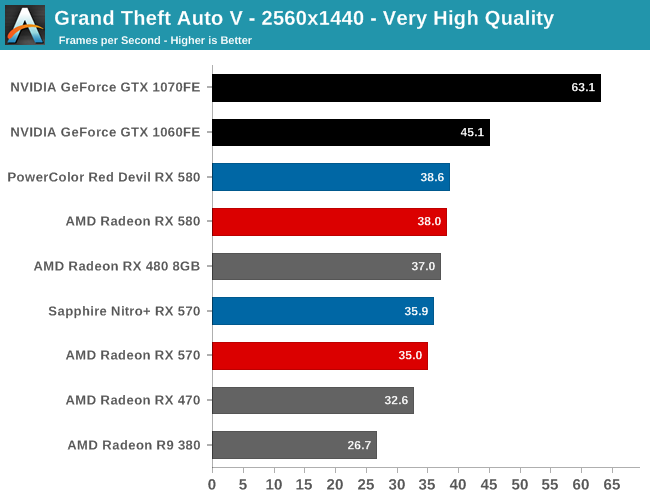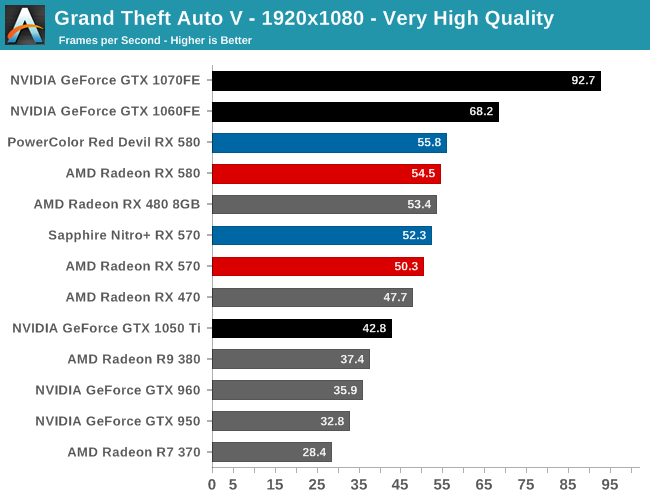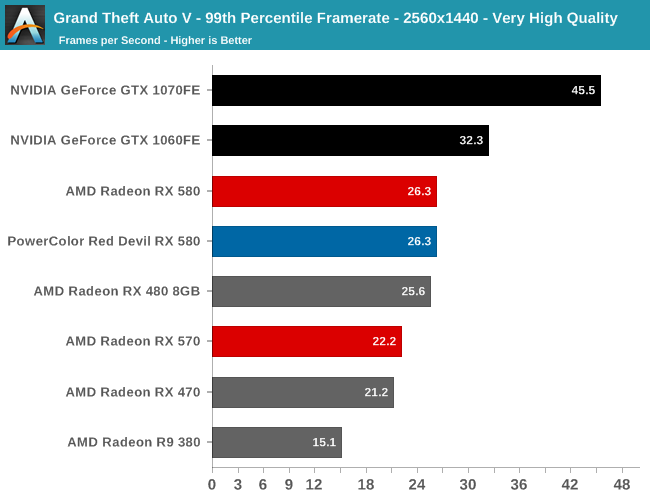The AMD Radeon RX 580 & RX 570 Review: A Second Path to Polaris
by Ryan Smith on April 18, 2017 9:00 AM EST- Posted in
- GPUs
- AMD
- Radeon
- Polaris
- Radeon RX 500
Grand Theft Auto V
The latest edition of Rockstar’s venerable series of open world action games, Grand Theft Auto V was originally released to the last-gen consoles back in 2013. However thanks to a rather significant facelift for the current-gen consoles and PCs, along with the ability to greatly turn up rendering distances and add other features like MSAA and more realistic shadows, the end result is a game that is still among the most stressful of our benchmarks when all of its features are turned up. Furthermore, in a move rather uncharacteristic of most open world action games, Grand Theft Auto also includes a very comprehensive benchmark mode, giving us a great chance to look into the performance of an open world action game.
On a quick note about settings, as Grand Theft Auto V doesn't have pre-defined settings tiers, I want to quickly note what settings we're using. For "Very High" quality we have all of the primary graphics settings turned up to their highest setting, with the exception of grass, which is at its own very high setting. Meanwhile 4x MSAA is enabled for direct views and reflections. This setting also involves turning on some of the advanced redering features - the game's long shadows, high resolution shadows, and high definition flight streaming - but it not increasing the view distance any further.
Otherwise for "High" quality we take the same basic settings but turn off all MSAA, which significantly reduces the GPU rendering and VRAM requirements.














129 Comments
View All Comments
TheinsanegamerN - Tuesday, April 18, 2017 - link
So this is ReBrandeon 2 - the search for more money?There is almost 0 improvement here. The XFX 480 GTR 1338 edition was already capable of hitting these performance numbers, with a better PCB and lower power consumption to boot.
Calling this a 580 is a mistake. You'd think they would have learned from the 300 series's massive mistake.
ABR - Thursday, April 20, 2017 - link
Might mean that they are planning on rebooting the naming scheme for Vega.willis936 - Tuesday, April 18, 2017 - link
*sighs audiblygoodtofufriday - Tuesday, April 18, 2017 - link
rx580 @ 185w - "look elsewhere for mitx"? r9 nano is 275w. 1070 strix 180w is in my ncase m1 itx with a 700w psu. please explain your reasoning.ajlueke - Tuesday, April 18, 2017 - link
"r9 nano is 275w". Actually the TDP of the R9 Fury Nano is listed at 175W. Which is actually an interesting point, as it still outperforms the RX 580 while using less power.AMDs recent architectures, lie Polaris and Fiji don't really seem to benefit much from throwing more juice at them. The Fury Nano is a great example. A 175W TDP vs 275W on the Fury X with only about 10% difference in performance.
I haven't been following to closely, but perhaps there will also be a Vega "Nano" variant? That card may easily be a performance per watt champion. Hopefully they don't price it the same as the full speed variant like AMD did for the Fury Nano originally.
goodtofufriday - Tuesday, April 18, 2017 - link
Typo on the 175/275 but yes. I do agree with all you said well. Which begs the question of why the writer says to look elsewhere for ITX soley based on the 35w increased tdp.Orumus - Tuesday, April 18, 2017 - link
I work 2 jobs and don't have a lot of time to read full reviews which is why I really appreciate the great "Final thoughts" section on most of your reviews. I can almost always count on it to give a concise yet nuanced overview of the overall review and technology in question. Thanks for making my life just that little bit easier.Yojimbo - Tuesday, April 18, 2017 - link
Good review, but I have a couple comments. Firstly it would be nice to have 1060 3GB benchmarks as well as a few more 1050 Ti benchmarks. Secondly, I don't think it makes sense to clock the Powercolor and Sapphire cards to AMD stock frequencies and list them as if they are AMD stock cards going up against the NVIDIA reference designs in the "Power, Temperature, and Noise" charts. Since these results are highly board-specific, I think you should explicitly write in the charts that it's a Powercolor clocked at stock rather than "AMD Radeon RX 580". An apples to apples comparison would be some factory overclocked board partner card based on the NVIDIA GPUs similarly downclocked to reference clock speeds.milli - Tuesday, April 18, 2017 - link
Isn't the game selection getting a bit old? Nothing newer than year old games.Crysis 3 and Battlefield 4 are (almost) 4 years old.
Add Doom to have one Vulcan game.
Computerbase.de tests with more and newer games. The RX580 ends up 1% faster than the GTX1060FE there.
https://www.computerbase.de/2017-04/radeon-rx-580-...
webdoctors - Tuesday, April 18, 2017 - link
If you're looking at these cards, you're likely not going to be buying the newer games. You'll likely be buying humble bundle or bundle star class games for your kids or feed your gaming addiction. Those generally have pretty reasonable GPU requirements. Games less than a year old are gonna be $40 a pop, 5 of those are equal to the price of a 580 which is unrealistic for someone buying a 580 to spend on SW.If you weren't cheap you'd go the Nvidia route, but at the sale prices the AMD cards are giving great value. Value gamers aren't buying the latest and greatest games.